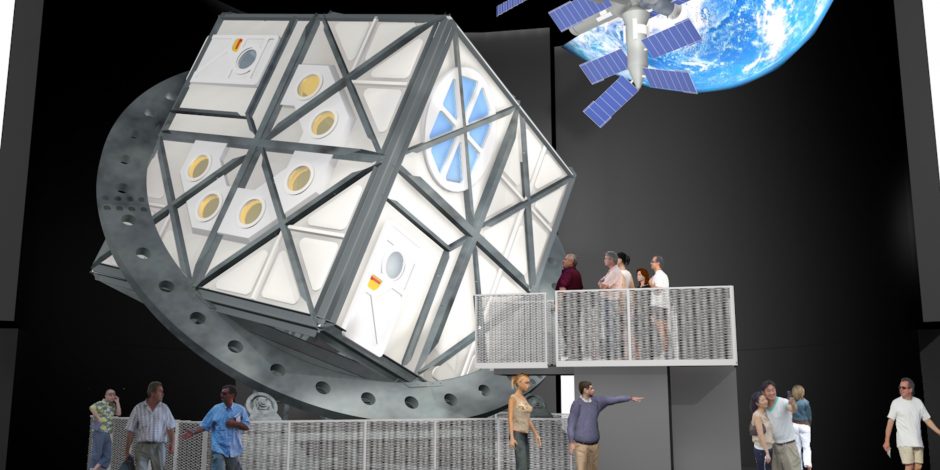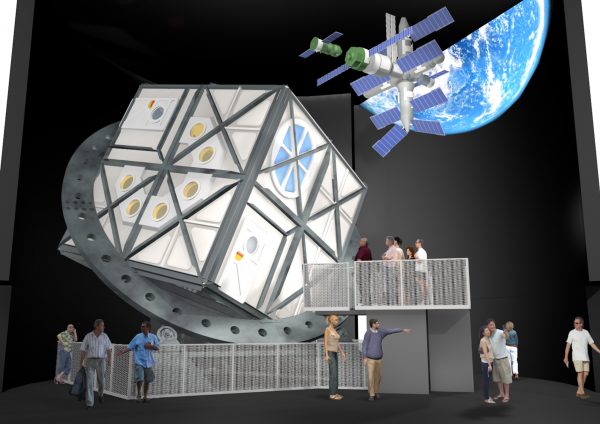Prepare for Lift-Off with the Space Transformer

On 24 November 2016 the completely redesigned permanent space exhibition at the Museum of Transport in Switzerland will open its doors to the public. “Space – The Exhibition” is designed so that visitors can experience a predetermined course through various areas and adventure experiences relating to the theme Space and Space Exploration. The exhibition was developed with the participation of the NCCR PlanetS.
An authentic Ariane 5 payload fairing located in front of the Aerospace Hall draws attention to the changes made to the exhibition. A spiral staircase, whose core is modeled on an Ariane rocket booster, serves as the entrance to the new Space Travel exhibition. On the second floor, museum visitors will find the “Timeline”, a 45-meter-long row of display cases, which tells the history of space exploration from the pioneers to the present day with the aid of models, photos, videos and texts.
The research satellite EURECA (EUropean REtrievable CArrier) which was deployed into space by the Swiss astronaut Claude Nicollier on 1 August 1992 while he was aboard the Space Shuttle Atlantis, dominates the space in the upper section of the hall. The 4.5 tonne satellite circled the Earth for eleven months and carried out some 70 biological and technical experiments before it returned to Earth. EURECA has been part of the collection of the Museum of Transport since 2000.

The main attraction of the new exhibition in Lucerne: An accessible walk-in cube that rotates around its diagonal axis. (Image VHS)
Another exhibition area is dedicated to The Space Race, the historic Apollo missions, and lunar research. The highlights of this exhibition include a piece of real moon rock and the engineering model of the solar wind experiment which was developed by the University of Bern and was positioned by most Apollo missions even before the American flag was put on the moon.
The “Rocket Engineering” area of the exhibition is dedicated to the topic of rocket technology. In addition to a real rocket engine from the 1960s, various models are also on display, describing the development of rockets starting from the beginning to the present. Visitors can also pretend to be a rocket engineer by building the right rocket for a particular mission.
A circular room in the centre of the exhibition houses the main attraction: the “Space Transformer” is an accessible walk-in cube that rotates around its diagonal axis (see picture). One or two groups of five people can go inside simultaneously to see and experience how the ceiling becomes the wall and the wall becomes the ground. Just as in a space station “up” and “down” are relative terms. The “Space Transformer” is supplemented by various exhibits, one of which displays possessions from Claude Nicollier.
Those visitors brave enough to discover how the Mercury astronauts felt during training in the early 1960s, can try the “Multi-Axis Trainer” in pairs in the “Space Activites” section of the exhibition. In this area, visitors will also find a replica of the International Space Station (ISS) as well as a control centre with six monitors upon which live images from the ISS and current data from weather satellites can be seen.
Following in the footsteps of Matt Damon, visitors will also take a journey to Mars. This segment of the exhibition features a simulated landscape with three different Mars rovers, which even have some moving parts.
As its name suggests, the exhibition “Deep Space Exploration” is dedicated to deep space. In addition to the comet mission Rosetta and other space missions, the subject of Exoplanet research is taken up and the Space Telescope CHEOPS is presented. CHEOPS is the first ESA mission under Swiss management.
At the end of the tour, visitors land in an area of the exhibition dedicated to “Time & Space” where a philosophical discussion of the infinite cosmos and time takes place.
Categories: External Newsletter
